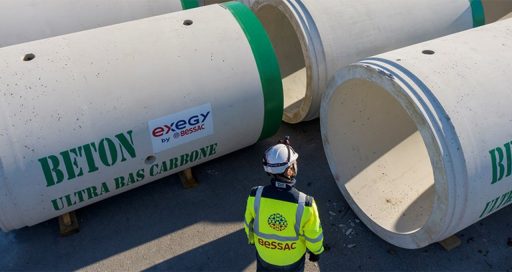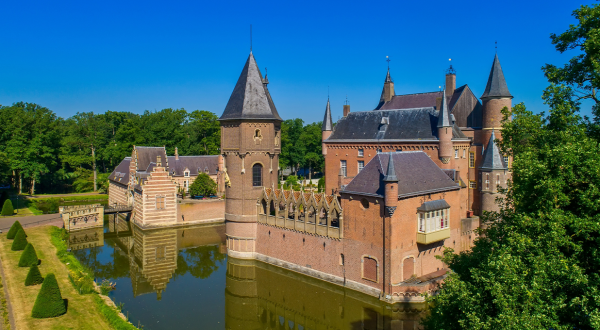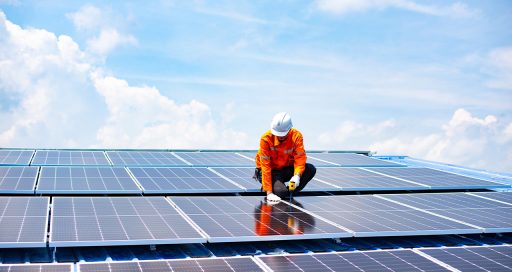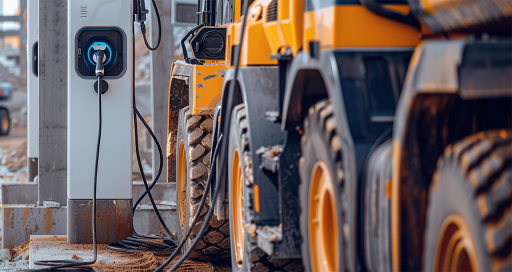Low-carbon concrete offers significant potential for decarbonisation in the construction sector. While its unique features may not yet be fully appreciated, especially by project owners, it is being used ever-more widely. Bruno Paul-Dauphin, Director of Exegy® Low-carbon Concrete Solutions at VINCI Construction, explains its features.

What is the potential for decarbonisation in the construction sector with low-carbon concrete?
Bruno Paul-Dauphin: Given the imperative to achieve the French national low-carbon strategy (SNBC) carbon neutrality targets for 2050, we must rethink construction methods and the use of materials such as concrete as a matter of urgency.
And at VINCI Construction specifically?
B.P.-D. For VINCI Construction, concrete accounted for around 25% of our Scope 3 CO2 emissions in 2019. Our ambition is to reduce our indirect emissions by 20% and to use 90% low-carbon concrete in our construction projects by 2030. We are certain that concrete remains one of the best construction materials for the future, provided that its global footprint and contribution to global warming are reduced. That’s why at VINCI Construction, since 2020, we have been developing low-carbon concrete solutions under the name Exegy®, which significantly reduce the CO2 emissions from concrete while maintaining strength and durability equivalent to those of conventional concrete. In 2023, 50% of the concrete used by VINCI Construction in its French building and civil engineering projects was low carbon.
What is the difference between low-carbon, extra-low-carbon and ultra-low-carbon concrete?
B.P.-D. first, let’s remember that low-carbon concrete is made by replacing some or all of the cement clinker, which has a very high carbon footprint, with mineral additions that have low CO2 emissions. These substitutes are generally blast furnace slag, fly ash, limestone filler and silica fume. To create reference points, in terms of emissions, which did not then exist on the market, in 2020, VINCI Construction drew up a matrix specifying its Exegy® standards alongside conventional concrete (strength classes C20/25 to C30/37): 200 kg of CO2 or less per cubic metre for low-carbon; 150 kg or less for extra-low-carbon; and 100 kg or less for ultra-low-carbon.
“Our ambition is to use 90% low-carbon concrete in our construction projects by 2030”
What are the advantages and disadvantages of clinker substitutes?
B.P.-D. Exegy® assigns equal importance to the technical performance of its concretes and their low carbon footprint. Although blast furnace slag is used for its high resistance to chemicals and to chloride ions in marine environments, its mechanical performance is equivalent or superior to that of cement. It is the technical characteristics of slag and fly ash – particularly their low hydration heat* – more than their low-carbon qualities that justify their use. They are currently in high demand, becoming harder to find and more expensive. VINCI Construction is therefore focusing on other additions such as limestone fillers. Limestone filler is weakly reactive on contact with water, and when added in large proportions to clinker and ultrafine additions such as metakaolins, calcined clays or silica fume, is a quality binder, available in quantity at a competitive price in France and around the world. The low proportion of clinker in these low-carbon binders negatively affects the strength of concrete at early age and requires heightened vigilance with regard to the fluidity and viscosity of these innovative concretes. Thanks to the experts at its laboratory in Marolles en Hurepoix, VINCI Construction has been using lower-carbon formulations for several years. They are currently working to reduce the downsides on projects using our solutions.
What changes are involved in the adoption of low-carbon solutions?
B.P.-D. Low-carbon concrete is causing a paradigm shift. It is leading us to rethink our methods, because it takes longer to set. In cold weather, VINCI Construction site workers plan for later formwork removal in their project scheduling. In some cases, it will also be necessary to use different equipment. For example, using heated forms to speed up hardening – a technique inspired by northern countries used to harsher winters. In France, low-carbon concrete can be used all year round. Extra-low-carbon requires additional thermal assistance in winter – using hot water to make the concrete, for example. Ultra-low-carbon is complicated to use in winter and needs heated water even in summer.
Is low-carbon concrete suitable for all applications?
B.P.-D. It can be used for any type of concrete structures poured on site and is perfectly suited to prefabricated concrete. However, low-carbon solutions are not yet suitable for prestressed concrete or sprayed concrete, which requires quick drying.
What are the next steps toward the massive-scale production of low-carbon concrete?
B.P.-D. VINCI Construction is focusing initially on low-carbon and extra-low-carbon concretes. In France, momentum is building, with 50% low-carbon concretes already being used on projects by VINCI Construction’s Bâtiment France and Génie Civil France divisions. Things are more complicated abroad, where standards are more conservative, legislation provides fewer incentives, or environmental awareness is less developed, and where awareness is lower in general. Some parts of the world already face logistical obstacles, having to ship clinker substitutes over long distances, which raises questions over their cost and carbon impact. And of course, the human factor cannot be ignored. Resistance to change plays a part, occasionally on site, but mostly on the part of our suppliers and project owners. But we are engaged in a transformation of the act of building, which requires fundamental changes in our activities and the shared conviction of all construction-sector stakeholders.
* Concrete’s heat of hydration plays a central role in the generation of thermal stresses and the resulting formation of cracks.
10/10/2024





